|
Tags: deep-sea fish | Fish Database of Taiwan
Off eastern, northeastern and southwestern Taiwanese waters, there are many unusual deep-sea fishes, including lantern fish, dragon fish, rattail cod, deep-sea anglerfish, and sharks. In order to adapt the deep-sea environment under 200m depth, they have developed long sharp teeth, expandable jaws and stomachs, and light organs.
深海魚的適應 Adaptation of the Deep-Sea Fish
The productivity is high and the food is sufficient on the ocean surface because of enough sun light. In order to avoid being eaten by predators on the surface, the zooplanktons that prey on the phytoplankton hide in waters below one hundred meters at daytime. The zooplanktons swim to rustle near the surface of the ocean for food at night and swim back to deep sea at dawn. In order to chase after the zooplankton, some deep-sea fishes swim back and forth day and night. Some deep-sea fishes that remain in the deep sea and wait for the subsided crumb of the food or debris. Some fishes use light organs to allure prey. Since there is food shortage, deep-sea fish is evolved to have protruding huge mouth on maxilla and under jaw and flexible and extended alimentary canal in order to store more food and prolong the digestive time. Carnivorous animals and scavengers are common in deep-sea environment.
Light organs are important part for deep-sea fish. There are two major types: commensal fungous light and body's chemical light. Light organs are used to mimic, allure preys on distinguish species and its opposite sex, and deceive enemies. Light organs on the belly of deep-sea fish can produce waves of light as the light shines into the surface of the water. Predators may get confused when looking straight up. Deep-sea fish can use light organs to protect themselves and cheat the enemies.
Lantern fish
Lantern fish accounts for the majority of the vertebrates in the ocean. It is also an important economical fish and becomes the major food for mammals in the ocean. Round light organs line on the front of the head, near the eyes, below the sidetrack of the body, and above the tail. Numbers and arrays of light organs vary due to different types of lantern fish. Some lantern fish has a light organ on the tail very much like a car taillight. Some has a large light ball as the lantern in ancient time of China. Light cells are circled by cells of light reflection. Light organs on the cytochrome level are similar to the structure of a searchlight. The structure of lens releases brighter light.
Dragon fish
Dragon fish is unique in its shape. Sharp and long teeth in the huge mouth are the tool for ingestion. In addition, the side of the body lay many light organs. Light organs are used to allure preys or distinguish the types or genders. Some types of dragon fish have the beaming vibrissae on their under jaws. Preys are ensnared through the movement of the vibrissae. Swallowing the food with big mouth is the typical action of the dragon fish. Due to the lack of food in deep sea, dragon fish does not miss any opportunity of eating everything regardless of its size. Dragon fish can swallow the prey that is bigger than itself. The upper and lower jaws of chauliodus sloani looks like chains and can make a huge mouth. Moreover, no preys can escape from the sharp teeth on the jaw that grows inward.
Sternoptychidae
Sternoptychidae belongs to stomiidae. According to the appearance, sternoptychidae can be divided into two genuses. One is and the other is sternoptychidae. Sternoptychidae is also called hatchetfish. Hatchetfish gets the name from its shape. Hatchetfish is tall and flat on the side. The front part of the body looks like the edge of an axe of the hatchet and the back part looks like a knife handle; therefore, it is called hatchetfish. On the rim of the back is black line. Black line is often mistaken as one part of the sea when being looked straight down by the predator. A light organ lines along the belly. Because of its insignificant contour, hatchetfish is often neglected by predators when looks straight up.
Deep-sea anglerfish
The first dorsal fin is deep-sea anglerfish's major feature. The first dorsal fin is also called illicium or a fishing rod. At the end of the illicium is a light organ. There is a big difference between adult male and female anglerfish. After the metamorphosis of young fish, female fish becomes bigger and bigger. It would grown up to one meter long and it has the structure as a fishing rod. Male fish degenerate to one or two centimeters. Therefore male fish parasitize on female fish. Fiber and blood vessels connect the parasitized parts. Male fish live on female's blood. The light system of deep-sea anglerfish shines and is used to allure the creatures in deep sea.
Rattail Cod
Rattail cod is one important species of deep-sea fishes and there are many types of them. Rattail cods are distributed in waters around the world except for the Pole. Most of them live in the waters between 200 to 2000 meters, and few can be found in deep-sea of 2000 to 6000 meters. On record, one was found as deep as 6500 meter below the sea. Most of the rattail fish lives in the continental shelf. Rattail fish uses its sharp nose to delve and prey small benthic fauna, fish or cephalopod on the seabed. Rattail fish uses its mouth below the head to digest. The breeding season is around end of winter to early spring. Rattail fish lays eggs on the bottom of the deep sea and the eggs would float on the surface. Parr would dive into the bottom of deep sea after it is hatched.
Deep-sea shark
About 394 species of sharks around the world have been identified by the scientists, and 241 species among all are deep-sea shark (61.6%) and 136 species live in the water below six hundred meters. Majority of deep-sea sharks are squaliformes and carcharhiniforms. Of the entire twenty-two types shark's lifestyle, seventeen types remain in the deep sea. Squaliformes and scyliorhinidae are the most commonly seem in deep-sea trawl. Of all the deep-sea sharks, only twenty-four types immigrate vertically. Among all the deep-sea squaliformes sharks, only sharks of etmopteridae and daliatiidae can illuminate.
Biology on deep-sea fish is still a new research field. There is insufficient studies being done, hence, analysis and management of resources can not be carried out. Epicontinental sea fishery has been dried out before being monitored properly. Therefore, in order to develop bottom trawl fishery in deeper waters, a better understanding and study on deep-sea creature is crucial. Therefore, the further usage on deep-sea fish resources will be meaningful. The increase on the budget on deep-sea creature is limited. With the efforts and supports, we can have better study and understanding of deep-sea creatures.
臺灣動物相典藏之研究:臺灣魚類相之數位典藏
Data on Expert Team
ResearchCenter for Biodiversity, Academia Sinica
The Fish Database of Taiwan http://fishdb.sinica.edu.tw/
| Nemichthys scolopaceus belongs to nemichthyidae family. The longest length can be up to 130 centimeters. Nemichthyidae has three genus and nine species in the world. Only one genus and one specie have been found in Taiwan. It is called nemichthus scolopaceus because its body is long and thin as an eel and a thread, but thinner than an eel.(Preserved at Fish Research Room of Research Center for Biodiversity, Academia Sinica and photo by Yunchih Liao) |
 |
Eurypharyngidae
|
Eurypharynx pelecanoides is Eurypharngidae. There's only one genus and one specie of Eurypharngidae has been discovered in the world. A light organ situated on its back. Eurypharynx pelecanoides do not do vertical move.
(Preserved at Fish Research Room of Research Center for Biodiversity, Academia Sinica and photo by Yunchih Liao) |
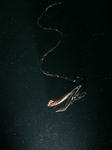 |
|
Pavoraja sp. has not been identified on family categories. It belongs to Rajidae and it is benthopelagic. Pavoraja can be seen in all oceans and seas around the world. Pavoraja lives on benthopelagic creatures.
(Preserved at Fish Research Room of Research Center for Biodiversity, Academia Sinica and photo by Yunchih Liao) |
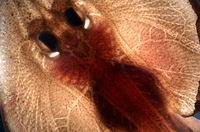 |
|
Ceratias has not been identified on family categories. It belongs to ceratiidae. Deep-sea ceratias parr floats on the epilimnion and moves to the deeper of the ocean as it matures. Ceratias can be seen from below surface 200 to 6000 meters. Ceratias can be found from the South Pole to the North Pole, but never be seen in the Mediterranean.
(Preserved at Fish Research Room of Research Center for Biodiversity, Academia Sinica and photo by Yunchih Liao) |
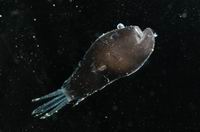 |
|
Bathypterois atricolor belongs to ipnopidae. The ipnopidae has six genus and twenty-nine species, but only one genus and two species are found in Taiwan. It is benthopelagic, which can stand on the bottom of the ocean with its long ventral fin and tail fin. It is also called the triangle fish.
(Preserved at Fish Research Room of Research Center for Biodiversity, Academia Sinica and photo by Yunchih Liao) |
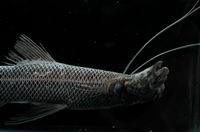 |
|
Chiasmodon niger belongs to chiasmodontidae. The longest length can reach up to twenty-five centimeters. It can be seen in the south waters in Taiwan.
(Preserved at Fish Research Room of Research Center for Biodiversity, Academia Sinica and photo by Yunchih Liao) |
 |
|
Gargariscus prinocephalus belongs to triglidae. It is also called spottyback searobin. Its longest length can reach up to thirty centimeters. The usual habitat for it is in waters at twenty to seventy meter deep.
(Preserved at Fish Research Room of Research Center for Biodiversity, Academia Sinica and photo by Yunchih Liao) |
 |
|
Astrongesthes Lucifer belongs to stomiidae. Its longest length can reach up to twelve centimeters. It can be seen in Xiao Liuchiu.
(Preserved at Fish Research Room of Research Center for Biodiversity, Academia Sinica and photo by Yunchih Liao) |
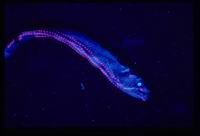 |
|
Malacosteus niger belongs to stomiddae. Its longest length can reach up to twenty-four centimeters. The range of its habitat is between zero to 2500 meters.
(Preserved at Fish Research Room of Research Center for Biodiversity, Academia Sinica and photo by Yunchih Liao) |
 |
|
Vinciquerria nimbaria belongs to photichthyidae. Its length can reach up to 4.8 centimeter. The range of its habitat is between twenty to five thousand meters. It is considered as the middle level fish. The parr and adult fish migrates vertically. It rustles in the afternoon and evening.
(Preserved at Fish Research Room of Research Center for Biodiversity, Academia Sinica and photo by Yunchih Liao) |
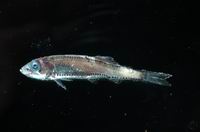 |
|
Chauliodus sloani belongs to stomiddae. Its longest length can reach up to thirty-five centimeters. Its habitat is located one thousand meter below surfact. It swims near to the surface at night. It preys the middle level fishes ad crustacea.
(Preserved at Fish Research Room of Research Center for Biodiversity, Academia Sinica and photo by Yunchih Liao) |
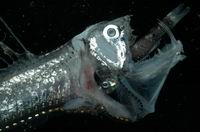 |
|
Astronesthes has not been identified on family categories. It belongs to stomiddae. Stomiddae has nine families, fifty-three genus, and about 248 species, but only fourteen species were found in Taiwan. For the past two years, roughly thirty species has been found by ResearchCenter for Biodiversity, Academia Sinica.
(Preserved at Fish Research Room of Research Center for Biodiversity, Academia Sinica and photo by Yunchih Liao) |
 |
|
Astronesthes chrysophekadion belongs to stomiddae. Its longest length can reach up to ten centimeters.
(Preserved at Fish Research Room of Research Center for Biodiversity, Academia Sinica and photo by Yunchih Liao) |
 |
|
Astronesthes Lucifer belongs to stomiddae. Its longest length can reach up to thirty-six centimeters. It can be seen in continental shelf and the bottom of the ocean where hill is.
(Preserved at Fish Research Room of Research Center for Biodiversity, Academia Sinica and photo by Yunchih Liao) |
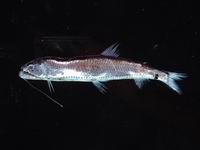 |
|
Triplophos hemingi, its longest length can reach up to thirty-six centimeters.
(Preserved at Fish Research Room of Research Center for Biodiversity, Academia Sinica and photo by Yunchih Liao) |
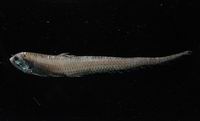 |
|
Argyropelecus aculeatus belongs to sternoptychidae. It is also called hatchet fish. Its longest length can reach up to 7.5 centimeters. It is widely distributed in waters around Taiwan. It is considered a middle level fish. It migrates day and night vertically, and swims between 200 and 550 meters at daytime and 80 to 200 at night.
(Preserved at Fish Research Room of Research Center for Biodiversity, Academia Sinica and photo by Yunchih Liao) |
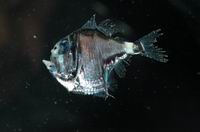 |
|
Pachystomias microdon belongs to stomiddae. Its longest length can reach up to 22.1 centimeters. It is considered as middle level fish.
(Preserved at Fish Research Room of Research Center for Biodiversity, Academia Sinica and photo by Yunchih Liao) |
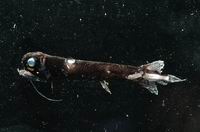 |
|
Bathophiulus nigerrimus belongs to stomiddae. Its longest length can reach up to 12.2 centimeters. It is considered a ond of the middle level fish.
(Preserved at Fish Research Room of Research Center for Biodiversity, Academia Sinica and photo by Yunchih Liao) |
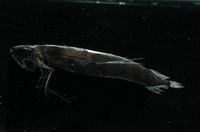 |
|
Cryptopsaras couesii belongs to ceratiidae. It is also called deep-sea anglerfish. Its longest length can reach up to forty-four centimeters. It is distributed mostly in the south of Taiwan waters. Its main habitat is in deep-water with dim or no light. It is sexual dimorphism. Male fish is short and small as a dwarf and lives on parasitism.
(Preserved at Fish Research Room of Research Center for Biodiversity, Academia Sinica and photo by Yunchih Liao) |
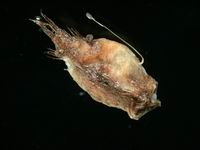 |
|
Rondeletia loricata belongs to rondeletiidae. It is also called whale head fish. It is distributed mostly in the south of Taiwan waters. It is considered as middle to bottom level fish. The range of its habitat is between 100 to 1130 meters. It usually stays in waters above 750 meters in the daytime and moves to waters at 100 meters at night.
(Preserved at Fish Research Room of Research Center for Biodiversity, Academia Sinica and photo by Yunchih Liao) |
 |
|































